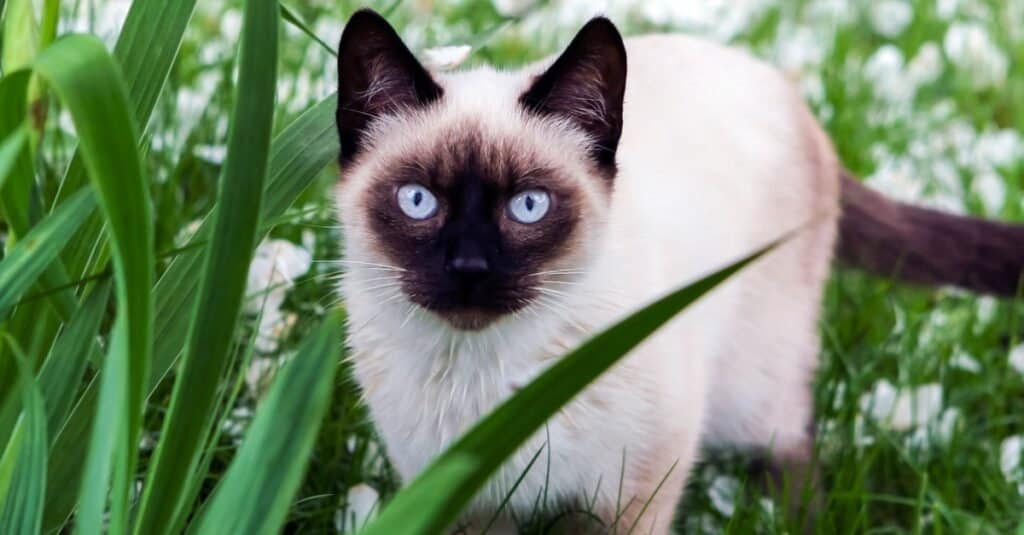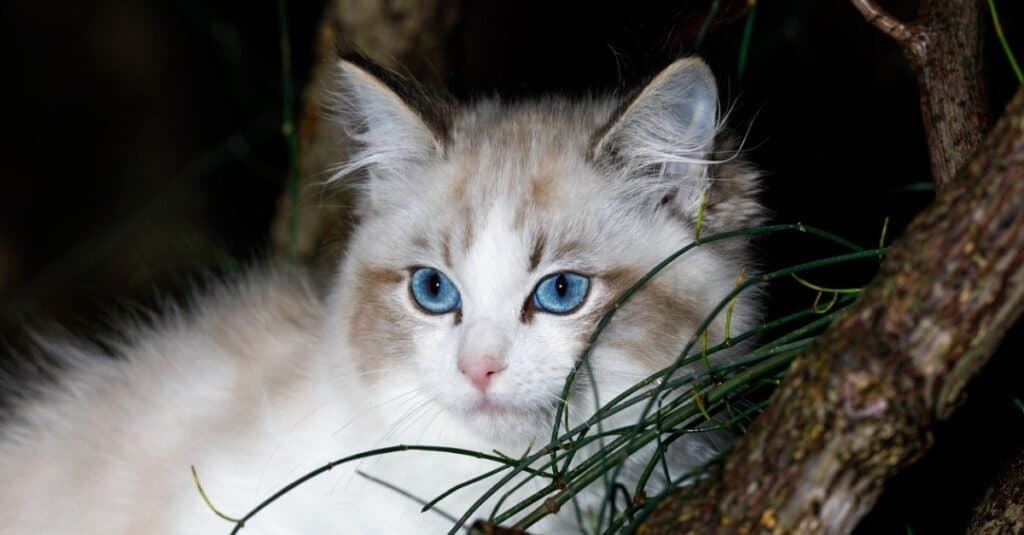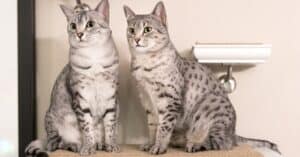There are 8.7 million species on the planet, and that means that you and your cat are just one tiny bit of representation in a diverse milieu of life. We share common ancestry with chimpanzees, squid, and even single-celled organisms — so it only makes sense that we share ancestry with the cats that live in our homes as well. But you might be surprised by how closely related we are.
In an attempt to make things more orderly, the system of taxonomy was invented. By employing an eight-part hierarchy of increasing specificity, it’s easier to tell how closely two species are related and what sorts of traits they might share with similar descendants. Humans, dogs, and dolphins are all mammals — but are cats? Let’s work our way through the taxonomy to find out — and figure out where exactly cats fit.
Kingdom: Animalia
Plants, fungi, and protozoa all fall into their own kingdoms, but cats fall under one of the most diverse and sophisticated kingdom of all: Kingdom Animalia. This kingdom constitutes every animal all the way down from the smallest ant to the most massive blue whale. All members of the animal kingdom are multi-celled and make use of aerobic respiration. Animals are capable of movement and reproduce sexually. Of course, we’ll need to make things significantly narrower if we want to get closer to the classification of a cat.

©iStock.com/Vital Hil
Phylum: Chordata
While a few members of the phylum Chordata don’t have backbones, the majority of its members are defined by possessing a spinal column that’s surrounded by nerve endings that extend to the rest of the body. Chordates are the most diverse phylum within the animal kingdom, but there are some similarities that are shared among most of them. That includes the at least rudimentary form of some sort of brain structure that directs sensory organs as well as a closed circulatory system for transporting blood throughout the body. All cats are unified by a sophisticated brain structure and sensory organs, but they share their phyla with creatures as wide-ranging as fish, crocodiles, and birds.
Infraphylum: Gnathostomata
While infraphyla aren’t universally recognized parts of the taxonomic system, they do allow for some narrower classification of a given phylum. Gnathostomes are vertebrates that possess a jawbone. Organisms under this classification are descended from cartilaginous and bony fishes, but members of Gnathostomata have managed to express this trait in increasingly sophisticated ways — whether that takes the form of the skull-crushing jawbone of the jaguar, the tool-like tusks of the African elephant, or the jagged mouth of a great white shark.
Superclass: Tetrapoda
As amphibians developed and began to crawl from the water for life on land, they gave birth to the identification of superclass Tetrapoda — and all of their descendants fall into that category. That said, not all modern tetrapods continue to have four legs. Snakes and whales in particular lost their legs over the course of generations, but they continue to be descended from the earliest tetrapods. Others, like humans and other apes, have adapted to walk on two legs and have developed their front legs into more delicate tools for manipulation.
Cats have retained the four legs of their tetrapod ancestors and have adapted them to be more effective killers — with members of the cheetah species capable of reaching speeds of up to 80 miles per hours. Others — like the black panther and even the domesticated pet cat — have adapted their four legs to climbing and can navigate tree canopies as ably as they can the ground.
Class: Mammalia

©iStock.com/Thomas Leirikh
It’s been roughly 200 million years since the first mammals came into being, but they continue to be a fascinatingly diverse and innovative form of life. The earliest mammals lived along dinosaurs, and the most important distinction separating them from their reptilian and amphibian forebears was the efficiency of their metabolism which allowed them to stay active for longer periods rather than having to operate in short bursts. While some dinosaurs and birds are also warm-blooded, the efficiency of mammalian metabolisms has allowed them to thrive and cover the planet today. There are six other traits widely recognized in mammals.
- Sophisticated inner ear — The three bones that make up the inner ear of every mammal allow for sophisticated hearing that can evaluate pitch, tone, direction, and other distinctions and translate them into complex neural impulses. The shape of feline ears and the complex muscles that allow them to control each ear independently provide them with a sense of hearing that goes well beyond that of both humans and dogs.
- Mammary glands — All mammals can produce milk to nurse their young, and almost all mammals have grown nipples to assist with the process of nursing. Rare exceptions like the duck-billed platypus never developed nipples, and don’t give birth to live young — but they still have mammary glands and produce milk. The average domestic pet cat will nurse for six to eight weeks before moving on to solid food.
- Hair or fur — While the color, thickness, and pattern may vary, every mammal on the planet grows some sort of fur or hair. This primarily serves as a form of insulation against the cold, but it can also be used for camouflage or even a defensive measure — as is the case with the quills of a porcupine. Cats are no exception! Even the allegedly bald Sphynx cat has a soft layer of downy hair. The whiskers that stick out of a cat’s face are actually fut too — and they serve a special purpose as a sensory tool.
- Diaphragm — Lungs aren’t the exclusive province of mammals, but the success of class Mammalia has a lot to do with the efficiency of their diaphragm. The diaphragm helps regulate airflow into the lungs — and when combined with the high metabolism of mammals, it allows them to be more mobile and active than many other animals. In addition to helping a cat breathe, the diaphragm is also used when a pet cat purrs.
- Hearts with four chambers — Every chordate has an internal circulatory system, but only mammals and birds have evolved to possess a four-chambered heart. The result is a more efficient cardiovascular system than amphibians, fish, and reptiles. This is another evolutionary factor that allows mammals to remain active and push themselves to further feats of physical stamina. In the case of a cheetah, that means transitioning from a resting heart beat of 120 beats per minute to an active rate of 250 BPM in a matter of just a few seconds. It’s not just the speed that makes them such efficient predators. It’s the acceleration as well.
- Lower jaws made from one bone — Hinged jaws aren’t unique to mammals, but all members of the class are defined by the presence of a hinged jaw with a lower jaw made of a single piece. The hinges holding this jaw together create an efficient method for mastication. In a creature like a cow, this strength can help them grind down coarse and fibrous vegetation. Cats in particular have developed jaws that can open very wide, allowing them to snap the necks of prey with a single bite.
Summary
There is never a shortage of Cats looking for a good home. Female cats can have 2 litters of kittens per year with many kittens in each litter. As a result, the number if cats from that one littler can increase exponentially over time. These cute little mammals should be kept indoors.
Up Next…
- All Of Your Cat’s Crazy Behaviors, Explained Do you wonder why cats do some of the crazy things they do? Check out this article to learn more about their behavior.
- Cat Gestation Period: How Long Are Cats Pregnant? There is never a shortage of cats looking for a new home. Find out just how long it take to produce a litter of kittens.
- Cat Breeds Find out more about some of the purebred cats that are available.
The photo featured at the top of this post is © Kristi Blokhin/Shutterstock.com
Thank you for reading! Have some feedback for us? Contact the AZ Animals editorial team.






